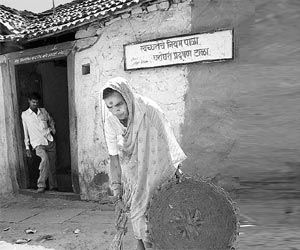The Right Model
Kaldhari in Pune district is a model village with its cleanliness campaign and social initiatives. But things are far from perfect

Kaldhari in Pune district is a model village with its cleanliness campaign and social initiatives. But things are far from perfect
Narayan Durgade,the English teacher in Kaldhari village,has never had to spend much time on Chapter 4.4 of the Class XII textbook of the Maharashtra State Board. It was,after all,on something they had all grown up withthe chapter talks of their village Kaldhari and its status as a model village.
Around 60 km from Pune,Kaldhari announces itself soon after the lush green terrain makes way for rocky,tanned surroundings. As you close in,the roads get bumpier and the earth looks shrivelled but Kaldhari has long been on this route to be one of the most progressive villages in the state.
monthly limit of free stories.
with an Express account.
The village of 2,250 people has taken the lead in implementing several projects such as a toilet block in every house,a gobar gas project and lights powered by solar and wind energy. The village has been receiving the Sant Gadgebaba Clean Village Campaign Award for the last eight years and has also won this years Nirmal Gram Puraskar.
The village also has a water conservation scheme,where 80 thousand litres of water are pumped from four wells into a couple of reservoirs. The basalt base makes it difficult for water to percolate and the only way it can be saved is through water harvesting. But this is where the topography and soil play spoilsportthe water cant be diverted to the fields because of the uneven landscape. The water,though,finds its way to 30 common taps across the village.
In the last eight years,we have received up to Rs 20 lakh through various awards. The cleanliness campaign started in 2000 when all of us decided to voluntarily participate in every development activity. The main aim was cleanliness and water conservation. The transformation you see here comes after years of hard work, says Narhar Deo,member of the cleanliness committee in the village.
The man responsible for these initiatives is Ankush Parkhande,the deputy sarpanch of the village. This place was extremely depressing a few years ago. In 2000,when the government introduced the cleanliness campaign,we knew this was our chance to set things right. Now each of the 436 houses has a toilet block for which the grampanchayat gives a subsidy of Rs 2,000. Around 154 families have gobar gas plants,40 families have solar panels and we have 15 solar street lamps. There are four kindergartens,six primary schools and one high school.
The significant part is that the village finances these projects with the prize money it gets,without any political backing. Parkhande has been sarpanch for 15 years and devotes 12 hours every day for community work.
Shivaji Mhangre,a villager,has constructed two toilets outside his home. The other one is for visitors but the toilets are connected to the gobar gas plant behind my house and the gas is used for cooking. I have invested almost Rs 8,000 in each toilet block.
The village has taken up many other initiativesan anti-alcohol drive,milk cooperatives,a chilling plant to store milk,smokeless chulhas,reservoirs and wells to harvest rainwater,a veterinary hospital,a clinic and womens self-help groups.
Vimal Chikne is the member of one such group. We are 12 women in all. We cook for the school children and get some additional income. This helps us sustain ourselves when the going is tough, she says.
But despite the good work,the village has its share of worriespoverty and migration. On average,at least one member from each family has moved to nearby cities in search of work.
Shakuntala Bhosle,a villager,says her farmer son is jobless and earns a pittance from transporting manure from the village to markets nearby. After the harvest season,there is no work. We have a couple of goats and cattle but this is just not enough. It is good to be part of this village that has brought us fame but…, she trails off.